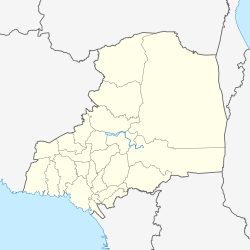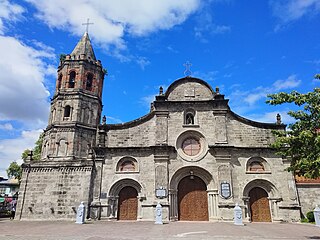
Bulacan, officially the Province of Bulacan, is a province in the Philippines located in the Central Luzon region. Its capital is the city of Malolos. Bulacan was established on August 15, 1578, and part of the Metro Luzon Urban Beltway Super Region.

Meycauayan, officially the City of Meycauayan, is a 1st class component city in the province of Bulacan, Philippines. According to the 2020 census, it has a population of 225,673 people. It is one of the oldest towns in the province.
The Cross of Sitio Torril is probably the oldest religious relic in the town of Meycauayan, Bulacan in the Philippines. It is crafted in the late Baroque style and is dated by Philippine church history expert Regalado Trota Jose at around the late 17th century. Although it may be the oldest church relic found in Meycauayan, it is doubtful that it came from the parish founders Diego de Oropesa and Juan Plasencia.

Bulakan, officially the Municipality of Bulakan, is a 1st class municipality in the province of Bulacan, Philippines. According to the 2020 census, it has a population of 81,232 people.

Balagtas, officially the Municipality of Balagtas, is a 1st class municipality in the province of Bulacan, Philippines. According to the 2020 census, it has a population of 77,018 people. The municipality is 30 kilometers (19 mi) from Manila and is 15 kilometers (9.3 mi) from Malolos City.

Calumpit, officially the Municipality of Calumpit, is a 1st class municipality in the province of Bulacan, Philippines. According to the 2020 census, it has a population of 118,471 people.

Guiguinto, officially the Municipality of Guiguinto, is a 1st class municipality in the province of Bulacan, Philippines. According to the 2020 census, it has a population of 113,415 people. It is 34 kilometers (21 mi) from Manila and 11 kilometers (6.8 mi) from Malolos City.

Marilao, officially the Municipality of Marilao, is a 1st class urban municipality in the province of Bulacan, Philippines. According to the 2020 census, it has a population of 254,453 people. It is 22 kilometers (14 mi) from Manila and 23 kilometers (14 mi) from the provincial capital Malolos City.

Our Lady of Mount Carmel Parish, also known as Barásoain Church is a Roman Catholic church built in 1888 in Malolos, Bulacan, Philippines. It is under the jurisdiction of the Diocese of Malolos and is about 42 kilometers (26 mi) from Manila. Having earned the title as the "Cradle of Democracy in the East, the most important religious building in the Philippines", and the site of the First Philippine Republic, the church is proverbial for its historical importance among Filipinos.

The Diocese of Malolos is a Latin Church ecclesiastical jurisdiction or diocese of the Catholic Church in the Philippines, encompassing the whole Province of Bulacan and Valenzuela City in metropolitan Manila and is a suffragan to the metropolitan Archdiocese of Manila. The mother church of the Diocese is the Cathedral-Basilica of the Immaculate Conception located in Malolos City, Bulacan. The Blessed Virgin Mary, under the title of Immaculate Conception is the principal patroness of the diocese.
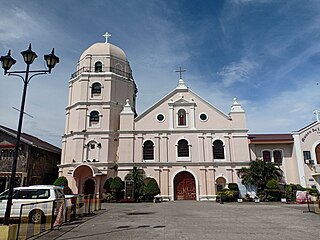
The San Pascual Baylón Parish and National Shrine of Nuestra Señora de la Immaculada Concepcion de Salambao, commonly known as Obando Church, is a Roman Catholic church located in the municipality of Obando in the province of Bulacan, Philippines. It is under the jurisdiction of the Diocese of Malolos.
Bulacan is a province of the Philippines. It was established on 15 August 1578.

The Archdiocesan Shrine of Santo Niño de Tondo, also known as Tondo Church, is a Roman Catholic church in Tondo, Manila established by the Augustinians. It houses an image of the Infant Jesus which originally came from Acapulco, Mexico and was handed over by a wealthy merchant to the Archbishop of Manila at that time, who later turned it over to the parish priest of Tondo, Manila. Since 1572, the image of the Santo Niño has been enshrined in this church.

The Diocesan Shrine and Parish of Saint Augustine, commonly known as Baliwag Church, is a Roman Catholic church located in Plaza Naning at the poblacion of Baliwag, in Bulacan province, Philippines. The church is a parish church of the Diocese of Malolos, which is a suffragan of the Archdiocese of Manila.
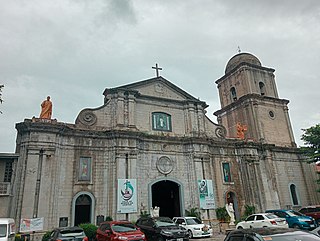
The Diocesan Shrine and Parish of Our Lady of the Pillar, commonly known as Imus Cathedral, is a Roman Catholic cathedral church in the city of Imus, in the province of Cavite, Philippines. The church serves as the seat of the bishop of the Diocese of Imus, the diocese that has jurisdiction over the entire Civil Province of Cavite.

Saint James the Apostle Parish Church, also known as Santiago Apostol Church, Plaridel Church or Quingua Church, is a 15th-century Roman Catholic church under the patronage of Saint James the Apostle and is located along Gov. Padilla street, Brgy. Poblacion, in Plaridel, Bulacan, Philippines. It is under the jurisdiction of the Diocese of Malolos. In 1961, a historical marker was installed on the church by the National Historical Committee.
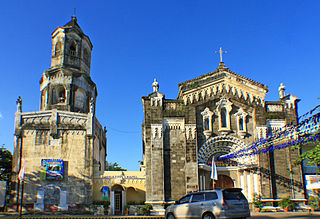
The Diocesan Shrine and Parish of Nuestra Señora de la Asuncion, commonly known as Bulakan Church, is a 19th-century Neo-Byzantine-Romanesque stone church located at Brgy. San Jose, in the Municipality of Bulakan, Bulacan province, Philippines. It is one of the parishes of the Roman Catholic Diocese of Malolos under the Vicariate of the Immaculate Conception. The church was declared Marked Historical Structure of the Philippines in 2007 by the National Historical Institute, the precursor of the National Historical Commission of the Philippines. A historical marker bearing a brief history of the church was installed by the commission.

San Ildefonso de Toledo Parish Church, commonly known as Guiguinto Church, is an 18th-century, Baroque Roman Catholic church located along the MacArthur Highway, Brgy. Poblacion, Guiguinto, Bulacan, Philippines. The parish church, under the aegis of Saint Ildephonsus, Bishop of Toledo, is under the jurisdiction of the Diocese of Malolos. The church is connected to St. Martin de Porres Catholic school of Guiguinto, a private school in Guiguinto.

The National Shrine and Parish of Saint Anne, commonly known as Santa Ana Shrine or Hagonoy Church, is an 18th-century, Baroque Roman Catholic church located in Brgy. Santo Niño, Hagonoy, Bulacan, Philippines. The parish church, dedicated to Saint Anne, is under the jurisdiction of the Diocese of Malolos. It was declared a National Shrine in 1991. In 1981, the National Historical Institute, a precursor to the National Historical Commission of the Philippines, installed a marker with a brief history of the church.

The Parish of Saint Lawrence, Deacon and Martyr, also known as San Lorenzo de Roma Parish Church or Balagtas Church, is an 18th-century Baroque Roman Catholic church located at Brgy. Longos, Balagtas, Bulacan, Philippines. The parish church, dedicated to Saint Lawrence, is under the jurisdiction of the Diocese of Malolos.

